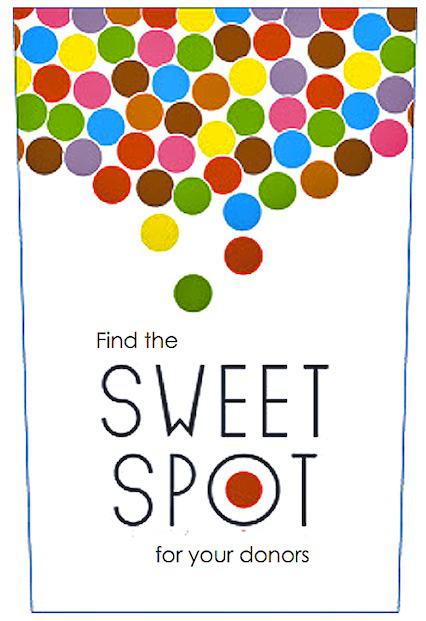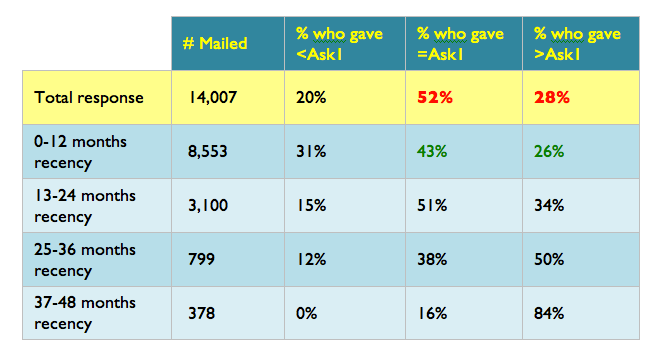Musings of a direct response fundraiser no. 2: finding the ‘sweet spot’
In the second article in his series on the practical essentials of direct fundraising Jonathon Grapsas of Flat Earth Direct sets out some priceless insights and lessons learned from testing what to ask your donor for in direct mail appeals.
- Written by
- Jonathon Grapsas
- Added
- December 10, 2014
When we talk about the science and rigour of direct marketing there is little that comes close to being as important as how much to ask for. Ask for too much and you risk annoying people. If you ask for too little, then that’s a risk also.
Our job as fundraisers is to find the sweet spot: an amount that is appropriate to that donor at that time. It’s not an exact science, but it is a science. The biggest indicator of what people (our wonderful, caring supporters) will do is what they have done most recently.
Rules of thumb
Here are some insights gleaned through several years of testing ‘asks’ (across several continents). Time and time again, they stack up.
- Acquisition: asking for less in direct mail acquisition usually results in more income. More new supporters through the door offset a lower average gift. For example we’ve found that asking for $20* will deliver you more income overall than asking for $25 (more donors, albeit at a lower average gift = more income).
- Appeals: asking for a gift of equal or greater value than you have asked in the past will generate more net income for warm, cash appeals. The caveat here is that you cannot ask for more than the previous gift in every appeal.
- If you send four appeals per year, ask for a ‘stretch’ gift in two of them. This could be a gift of equal value, or 25 per cent more than their highest gift made in response to an appeal during the last 24 months. For the other two appeals ask for a gift equivalent to an average of their last 24 months of gifts. It’s about maximising net income across the year, not just in one appeal.
- Monthly giving versus cash: ask for one, don’t give the option for both. You’ll make more cash overall if you just ask for cash at the exclusion of monthly gifts. Similarly, if you want monthly gifts ask for them only. Don’t give an easy way out with a secondary cash ask.
When it comes to ask amounts for cash supporters you’re hoping to ‘convert’ to a monthly gift, stick with asking for an amount equivalent to 10 per cent of their last cash gift. A $100 cash supporter will respond best when asked for around $10 per month. Again, there will be more responses (but lower average gift) than from those asked for $20 per month. The bottom line is that you will gain more net income by going lower.
So what is the sweet spot?

What’s this Holy Grail I keep banging on about? When you’re including ask amounts on your supporter base, you’re looking for around two out of three supporters to give what you asked them for, or more.
How do we know this? Years of testing, determining the ask amounts that delivered the most income and we found the ‘two out of three’ rule.
Here’s an example below.
You can see a data file split by recency. In this appeal, 80 per cent of supporters gave at or above the ask amount we’ve included in the appeal, which indicates that we could stretch some supporters a little further. However, the active segment (0-12 months) shows 69 per cent giving at or above the first ask so would be – in my view – hitting the sweet spot and shouldn’t require any tinkering. Whereas response from the lapsing and lapsed segments suggest we could ask for slightly more.

Some considerations
- Not everyone has a file size big enough to undertake testing that returns a statistically significant outcome. If you fall into this category follow the rules above.
- The experience and testing shared here have all been done via fundraising communications that include specific, personalised asks throughout. This means that if a donor’s highest gift previously was $100, in the next appeal he or she should be specifically asked for $125 several times in the appeal letter and the amount should be lasered on the response form. It should look something like this.
It highlights the life-saving role of a medical device called an ultrasound scanner – and why I’m asking you, Jonathon, to please send a gift of $125 today to help us purchase this desperately needed unit for our Neonatal Critical Care Unit.
- More specific asks = more income. Six asks throughout an appeal will beat five, five will beat four and so on. Aim to get at least one personalised ask on each page of your appeal as a minimum.
- All of the above insights assume you produce incredibly emotive fundraising appeals led by human stories. These appeals must be supported by highly personal and warm thanking, follow up and donor care, updating supporters about how their support has changed the world. Asking is futile without all of these key ingredients.
- ‘Soft’ asks are a little like the Loch Ness monster. Everyone claims to have seen them, but can’t prove anything related to them. If you’re going to ask, then do so properly. Base your ask on past behaviour and don’t be bashful, you’re here to change the world.
Final thought
Fundraisers are storytellers, but we’re also tasked with being data scientists. Follow the insights and learnings above and you’ll be well on your way to finding that all important ‘sweet spot’ that’ll net you more dollars for your cause than before.
© Jonathon Grapsas 2014
















